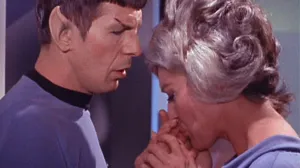The Joss Whedon TV series Firefly aired its single season for three months across the end of 2002, yet its fanbase endures to this very day. People still reference the show constantly online, while the production’s actors (namely Nathan Fillion and Alan Tudyk) are still showing up in projects together. Firefly’s got a massive shadow that looms large over the sci-fi genre on both the big and small screen. However, even with Firefly continuing to be an influential part of pop culture, it’s worth remembering that it aired in a radically different era of television than the one we live in now.
Videos by ComicBook.com
Dropping on the Fox network more than a decade before streaming programming was even invented (heck, even major cable and premium network productions were scarce in 2002), Firefly’s brief existence transpired within a totally unrecognizable part of television’s history. That unrecognizability includes a key reason why Firefly got cancelled, which would sound absurd to today’s TV audience.
Firefly’s Episodes Were Aired Chaotically

Today, many TV shows are dropped all at once in a “binge” format on streaming platforms. Meanwhile, genre productions airing in a weekly format do so firmly within a chronological fashion adhering to the wishes of the show’s creative team. The Mandalorian, The Last of Us, The Boys, and other genre programs never air episodes out of order. Even more recent genre endeavors on broadcast networks like Agents of S.H.I.E.L.D. didn’t deliver installments to viewers in a confusing fashion. To do so sounds like creative sabotage.
However, for much of TV’s history, broadcast networks often did just that. Shows would air episodes randomly out of order to satisfy the whims of executives or corporations that were paying for commercials. This phenomenon impacted everything from various late-2000s Lost knock-offs to Father of the Pride. Firefly also got caught up in this phenomenon, with Fox tossing out chronology to the wind in favor of just airing episodes randomly. The program’s pilot, “Serenity,” didn’t air until late December 2002, for instance, after 10 other episodes had aired.
[RELATED: Firefly Kills Off a Member of the Serenity Crew]
Needless to say, an episode written and conceived to be the launchpad for everything Firefly airing towards the end of the season was a nightmare scenario for all involved. Naturally, this meant story details that were supposed to unfold chronologically across Firefly’s first season turned into incoherent mush for viewers at home. Shows like Seinfeld can be watched out of order without a problem. Something more serialized like Firefly, though, required a more delicate touch that it never received.
Firefly’s Release Order Doomed Its Existence

Unable to make its lore and character arc coherent to general audiences due to circumstances far beyond its control, Firefly was a casualty of TV executives putting commercial interests over doing what’s best for a show. By the end of the decade, Fox would realize the severity of this mistake and start applying chronological release patterns for its genre shows. Fringe, for example, rarely aired episodes out of order. These programs live and die by their fanbases who want to digest mythos and lore in the order it was intended. Why not satisfy those souls?
Networks and streamers alike also didn’t really have a choice about how to properly release shows once the streaming revolution came. Now, audiences could click on a tab on Netflix or Disney+ and see entire season listings, complete with the proper ordering of each episode. The days of randomly turning on your TV on a Friday night and seeing what Fox’s new western sci-fi show was like were usurped by a new form of small-screen viewing. With that domain came new problems (such as Netflix’s inability to invest in many genre shows long-term), but it also meant genre shows didn’t suffer the same fate of Firefly.
Fox’s treatment of Firefly inspired such low ratings that, ironically, the show didn’t get to air all of its initial 14 episodes in the U.S., with only 11 airing in America. The release strategy Fox saw as assuring Firefly’s success pretty much doomed its chances to cultivate an audience. This cautionary tale from a radically different era of television storytelling didn’t stop Firefly from garnering its massive following, of course. While it looks like the time has passed for a revival, the show will undoubtedly continue to secure new fans and epitomize how not to air a genre TV show.
Firefly is now streaming on Disney+ and Hulu.








